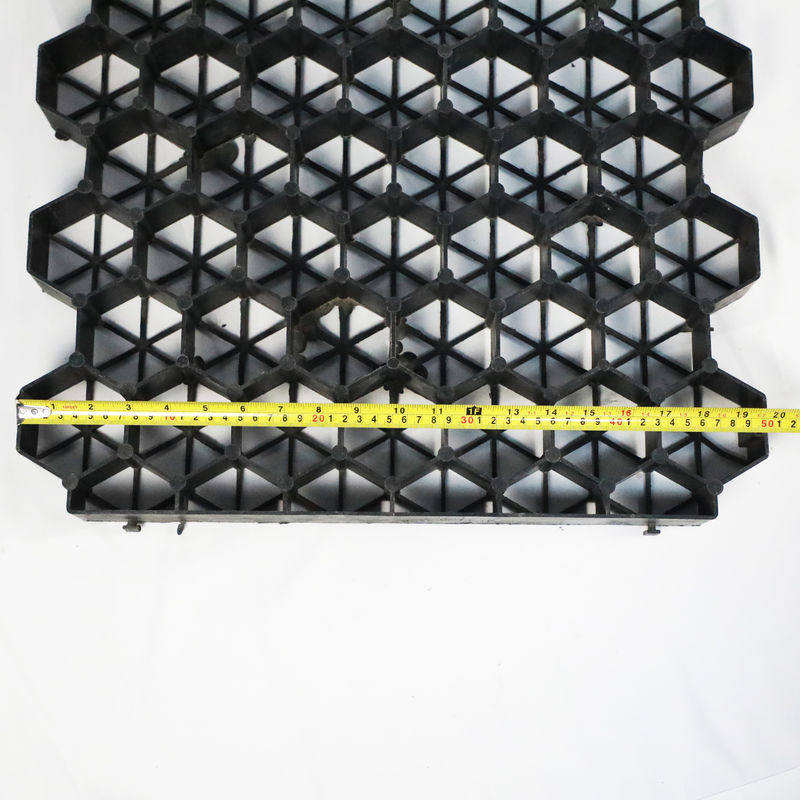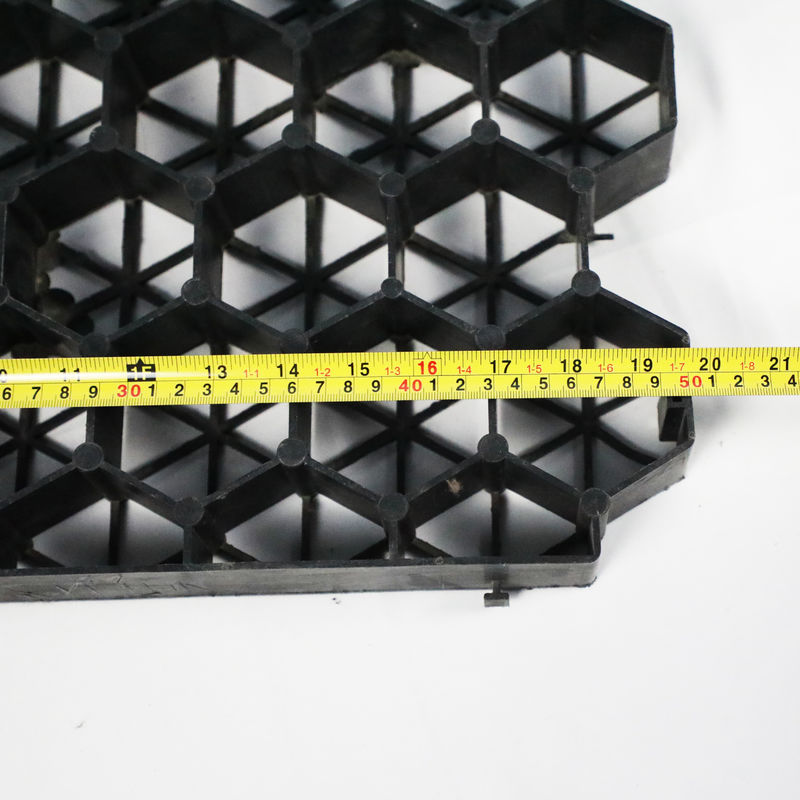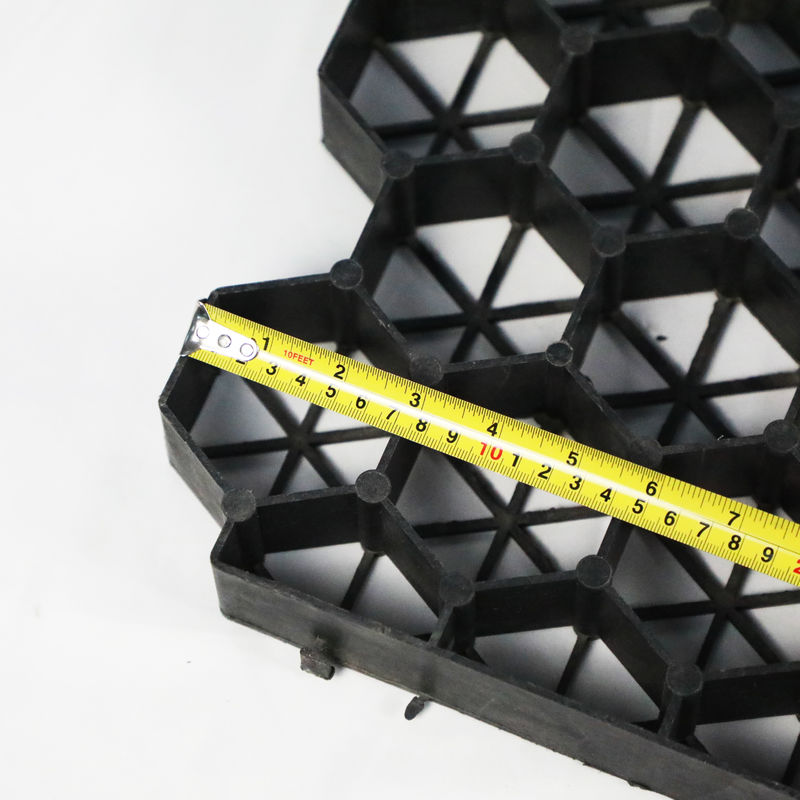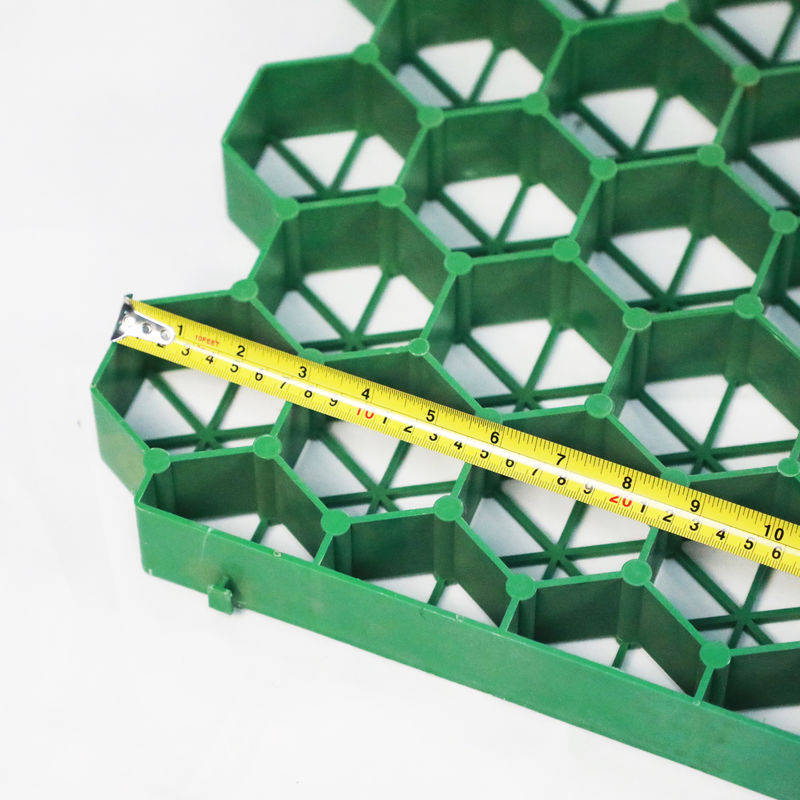Plastic Grass Grid for Parking Lot Fire Exit HDPE Pavers Geogrid for Landscape Ground Geocell Gravel Paddock Grid

Grass Grid: Structure, Material, Functions
Grass grid is an innovative and practical solution widely used in various landscaping and construction projects. Its structure and material composition endow it with multiple excellent properties.
In terms of structure, grass grid features a meticulously designed framework. It typically has a unique flat - plug lap joint construction, which not only ensures the structural integrity but also enables seamless connection between different grid units. The borders of the grass grid are equipped with a chain - like interface, facilitating quick and easy installation, allowing users to assemble large - scale grass grid systems efficiently.
Regarding materials, grass grid commonly utilizes high - density polyethylene (HDPE). This material offers remarkable durability and strength. Additionally, some grass grids are crafted from 100% recycled materials, highlighting an eco - friendly approach. The use of recycled materials not only reduces environmental impact but also makes grass grid a sustainable choice for construction projects.
One of the outstanding functions of grass grid is its excellent water permeability. Thanks to the specific design of the grass grid, rainwater can effortlessly penetrate through the surface and seep into the ground. This characteristic effectively drains excess water, minimizing the risk of waterlogging in the area. As a result, it relieves the burden on drainage systems, making grass grid an ideal option for regions prone to heavy rainfall.
Grass grid also boasts an impressive load - bearing capacity. It can evenly disperse the weight of vehicles and pedestrians on its surface. Whether it is a grass grid used for a private driveway, where family cars frequently pass, or a grass grid installed in a commercial parking lot, capable of withstanding the weight of multiple vehicles, this product provides stable support. By distributing the load evenly, grass grid reduces soil compaction, creating a more favorable environment for grass roots to grow deeper and stronger.
Environmentally, grass grid stands out as a green alternative to traditional paved surfaces. The grid holes in grass grid allow grass to grow through, transforming the area into a natural carbon sink. The growing grass absorbs carbon dioxide, improves air quality, and mitigates the heat island effect in urban areas. Moreover, the lush greenery created by the grass growing within the grass grid adds aesthetic value, blending harmoniously with the surrounding environment.
Another significant advantage of grass grid lies in its weed control and root protection capabilities. Grass grid forms a physical barrier that inhibits the growth of unwanted weeds, reducing the need for manual weeding or chemical herbicides. Meanwhile, it safeguards the grass roots from being damaged or crushed by heavy objects, ensuring the healthy growth of the grass and maintaining the overall appearance and functionality of the grass grid - covered area. In conclusion, grass grid, with its unique structure, diverse materials, and multiple functions, has become an indispensable element in modern sustainable construction and landscaping.


 Grass grid sell points
Grass grid sell points
1. Industrial-Grade Load-Bearing Strength
Crafted from high-density polyethylene (HDPE) or recycled wear-resistant materials, grass grids feature a scientifically engineered grid structure that supports 20–40-ton vehicles (and up to 800 tons/m² when filled). This makes them ideal for driveways, parking lots, and industrial zones, where they evenly distribute weight to prevent soil compaction and maintain long-term stability. Unlike traditional pavements, grass grids combine robust load capacity with eco-friendly design, ensuring durability without sacrificing green space.
2. 100% Permeable Stormwater Solution
The open-grid design of grass grids enables full water penetration, allowing rainwater to drain directly into the soil. This eliminates surface runoff, reduces urban flooding risks, and replenishes groundwater—aligning perfectly with sponge city initiatives. By minimizing reliance on drainage systems, grass grids offer a sustainable solution for managing heavy rainfall while promoting natural water cycles.
3. Eco-Conscious & Aesthetically Versatile
With 90%+ vegetation coverage, grass grids transform hardscapes into living ecosystems: grass absorbs CO₂, filters air, and mitigates the heat island effect. Many models use 100% recycled materials and are fully recyclable, reducing carbon footprints. Beyond functionality, the lush green lawns growing through the grids create visually appealing landscapes that blend seamlessly with gardens, parks, and commercial spaces—no more sterile concrete or asphalt.
4. Rapid Installation & Low Maintenance
Thanks to modular, snap-together designs (via buckle or chain interfaces), grass grids can be installed by one person in hours, with 50% faster setup than traditional paving. No heavy machinery or expertise is needed. Post-installation, the grids suppress 90% of weeds and protect grass roots from damage, cutting maintenance costs drastically. This makes them ideal for time-sensitive projects or low-effort landscapes.
5. Unmatched Versatility Across Scenarios
Residential: Driveways, pet areas, and garden paths that stay mud-free and green.
Commercial: Eco-parking lots, golf cart paths, and fire lanes that meet safety and sustainability standards.
Industrial: Temporary construction roads or heavy-machinery yards that minimize environmental disruption.
Public Spaces: Permeable walkways, equestrian arenas, and slope stabilization projects that balance durability with ecological benefits.
6. Long-Term Cost Efficiency
While grass grids have lower upfront costs than asphalt or concrete, their true savings shine over time: no cracking, fading, or costly repaving. With a lifespan of 10–15 years, they deliver 30–50% lower total costs than traditional surfaces—all while enhancing property value through green infrastructure.
Grass grid Application
1. Residential & Domestic Innovations
Grass grids redefine home landscaping by merging functionality with sustainability:
Driveways & Parking Areas: Swap concrete or asphalt for grass grids to create vehicle-friendly surfaces that support 20–40 tons of weight. These eco-conscious driveways reduce heat buildup, filter rainwater, and prevent soil erosion, while lush grass coverage eliminates unsightly tire marks and boosts curb appeal.
Gardens & Courtyards: Install grass grids as permeable pathways or patio edging to stabilize foot traffic while allowing rainwater to recharge the soil. In pet zones, they form a durable, mud-free layer that protects grass roots from digging and trampling, keeping yards tidy and pet-friendly.
Sloped Yards: On hillsides, grass grids anchor grass roots to combat erosion during heavy rains, transforming unstable slopes into stable, green landscapes.
2. Commercial & Public Space Solutions
For businesses and municipalities, grass grids offer practical sustainability:
Parking Lots: Shopping centers and stadiums use grass grids to create eco-parking areas with 90%+ vegetation, meeting green goals while managing stormwater and reducing the heat island effect. Some models even comply with fire code requirements for emergency access roads, blending safety with greenery.
Recreational Areas: Golf courses rely on grass grids to stabilize cart paths and tee boxes, protecting grass from heavy use while maintaining a natural look. In parks and equestrian facilities, they create permeable trails and arenas that reduce dust, erosion, and hoof damage to grass.
3. Municipal & Urban Sustainability
Grass grids play a key role in modern urban design:
Sponge City Initiatives: Integrated into city streets and plazas, grass grids manage rainwater runoff by allowing 100% water penetration, easing pressure on drainage systems and replenishing groundwater. This aligns with green infrastructure goals to improve air quality and biodiversity.
Public Transportation Hubs: Bus lanes and taxi ranks benefit from grass grids’ durable, low-maintenance surfaces, which add greenery to high-traffic urban areas without compromising functionality.
4. Industrial & Heavy-Duty Applications
In rugged environments, grass grids offer temporary and permanent solutions:
Temporary Roads & Construction Sites: Builders use grass grids as stable, grass-covered alternatives to gravel for vehicle access, minimizing environmental disruption during projects. In logistics yards, they support heavy machinery while reducing dust and enhancing site aesthetics.
5. Agricultural & Rural Utility
For farms and rural landscapes, grass grids optimize productivity and sustainability:
Grazing Areas & Farm Roads: In pastures, grass grids prevent soil compaction and mud, allowing grass to thrive under livestock movement. On farm roads, they create low-cost, erosion-resistant pathways that blend with rural scenery.
6. Specialized & Creative Uses
Grass grids adapt to niche needs, such as:
Rooftop Gardens: Lightweight grass grids stabilize soil and vegetation on green roofs, providing drainage, insulation, and a natural aesthetic for urban rooftops.


FAQ
1. Who are we?
We are located in China, and our products are sold to domestic market, Southeast Asia, Africa, Oceania, North America, South America, Eastern Europe, Middle East, Eastern Asia, Western Europe, Central America, Northern Europe, Southern Europe, South Asia.
2. How do we ensure quality?
Before mass production, we always provide pre-production samples;
Before shipment, we always do final inspection;
3. What can you buy from us?
Geomembrane/drainage board/drainage board/geotextile/geosynthetic clay liner/geogrid/geogrid
4. Why should you buy from us instead of other suppliers?
Geomembrane Geotextile Geogrid GCL Production Line
Installation Service
Technical Manual
ISO and CE Certification
Professional Sales Service
5. What services can we provide?
Acceptable Shipping Terms: FOB, CFR, CIF;
Payment Currency: USD;
Acceptable Payment Methods: T/T, L/C, Western Union;
Languages Supported: English, Chinese, Spanish

 Your message must be between 20-3,000 characters!
Your message must be between 20-3,000 characters! Please check your E-mail!
Please check your E-mail!  Your message must be between 20-3,000 characters!
Your message must be between 20-3,000 characters! Please check your E-mail!
Please check your E-mail! 



